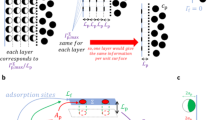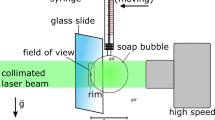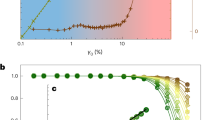Abstract
THE stability of soap films and colloidal dispersions involve the same forces, thus leading to the same type of curves for potential energy plotted against distance. Such curves frequently show two minima1 (Fig. 1). Stabilization in the secondary minimum at relatively large inter-particle separation distances (102–103 Å) is controlled by electrostatic double layer repulsion forces and this region of the curve has been investigated in some detail2 for aqueous soap films in air. Stabilization in the primary minimum at small separation distances (10–20 Å) has been considered to be governed by a short range repulsive force as a result of interaction between solvation layers a few molecules thick which are associated with the two flanking surfactant monolayers3. Any closer approach of the two interfaces entails desorption which manifests itself as a rapidly increasing repulsive force as successive solvation layers are removed4. Because of the lack of specific data, this short range repulsive force is conventionally represented in the potential energy diagram by a very steeply rising curve at a certain critical separation distance1, implying that primary minimum, or Perrin, films must be subjected to very large pressure differences before they can be further thinned. One method for investigating this region of the potential energy curve is to measure film thickness as a function of relative water vapour pressure.
This is a preview of subscription content, access via your institution
Access options
Subscribe to this journal
Receive 51 print issues and online access
$199.00 per year
only $3.90 per issue
Buy this article
- Purchase on Springer Link
- Instant access to full article PDF
Prices may be subject to local taxes which are calculated during checkout
Similar content being viewed by others
References
Duyvis, E. M., and Overbeek, J. Th. G., Proc. K. Ned. Akad. Wet., B65, 26 (1962).
Mysels, K. J., and Jones, M. N., Disc. Faraday Soc., 42, 42 (1966).
Clunie, J. S., Corkill, J. M., and Goodman, J. F., Disc. Faraday Soc., 42, 34 (1966).
van Olphen, H., An Introduction to Clay Colloid Chemistry (Interscience, 1963).
Corkill, J. M., Goodman, J. F., Ogden, C. P., and Tate, J. R., Proc. Roy. Soc., A, 273, 84 (1963).
Corkill, J. M., Goodman, J. F., and Ogden, C. P., Trans. Faraday Soc., 61, 583 (1965).
Clunie, J. S., Goodman, J. F., and Ogden, C. P., Nature, 209, 1192 (1966).
Derjaguin, B. V., Voropayeva, T. N., Kabanov, B. N., and Titiyevskaya, A. S., J. Colloid Sci., 19, 113 (1964).
Kitchener, J. A., Endeavour, 22, 118 (1963).
Author information
Authors and Affiliations
Rights and permissions
About this article
Cite this article
CLUNIE, J., GOODMAN, J. & SYMONS, P. Solvation Forces in Soap Films. Nature 216, 1203–1204 (1967). https://doi.org/10.1038/2161203a0
Received:
Published:
Issue Date:
DOI: https://doi.org/10.1038/2161203a0
This article is cited by
-
Surfactants for Bubble Removal against Buoyancy
Scientific Reports (2016)
-
A Model of Ball Lightning as a Formation of Water Molecules Confining an Electric Charge and the Classical Theory of the Electron
International Journal of Theoretical Physics (2012)
-
A re-interpretation of hydration forces near charged surfaces
Nature (1984)
-
Molecular layering of water at surfaces and origin of repulsive hydration forces
Nature (1983)
-
Solvation Forces in Soap Films
Nature (1968)
Comments
By submitting a comment you agree to abide by our Terms and Community Guidelines. If you find something abusive or that does not comply with our terms or guidelines please flag it as inappropriate.



